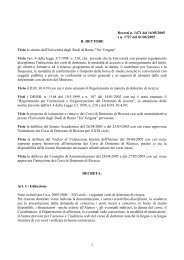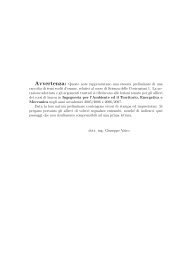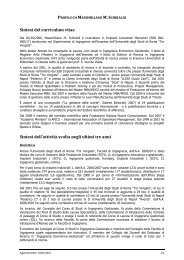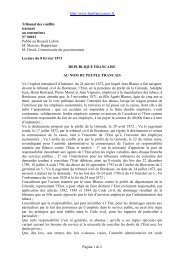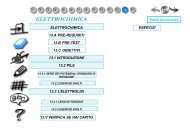Puneet Khandelwal, Soman N. Abraham and Gerard Apodaca
Puneet Khandelwal, Soman N. Abraham and Gerard Apodaca
Puneet Khandelwal, Soman N. Abraham and Gerard Apodaca
Create successful ePaper yourself
Turn your PDF publications into a flip-book with our unique Google optimized e-Paper software.
complex at the plasma membrane that includes the surface<br />
ganglioside GM-1 (81) <strong>and</strong> the cytoplasmic nonreceptor tyrosine<br />
kinase src (81). Upon binding the oocyte, sperm cells<br />
release a proteinase(s) that likely cleaves a conserved G-R-<br />
R188 motif in the membrane proximal region of xUPIIIa (82).<br />
The proteinase is probably related to cathepsin-B, which also<br />
recognizes peptides containing G-R-R residues <strong>and</strong> can cleave<br />
<strong>and</strong> activate xUPIIIa (82). Proteolysis of xUPIIIa activates src,<br />
which phosphorylates Tyr 249 in the cytoplasmic domain of<br />
xUPIIIa, <strong>and</strong> stimulates Ca 2� release downstream of Xenopus<br />
phospholipase C� (82), which signals resumption of meiosis II.<br />
Although it remains to be shown whether the UPs play a role<br />
in regulating signaling during urinary tract development in<br />
mammals, such a requirement could explain the significant<br />
abnormalities associated with loss of UPs in mammalian systems<br />
(99). It is also worth noting that G186 in xUPIIIa is<br />
equivalent to G202 in the conserved domain of human UPIIIa<br />
(Fig. 3B), the mutation of which results in renal hypodysplasia<br />
(179). Thus cleavage of human UPIIIa may play an important,<br />
but unknown, role in kidney development. Although these<br />
studies are suggestive, a recent analysis of bacteria-induced<br />
apoptosis provides striking evidence that UPIIIa-dependent<br />
signaling events may occur in mammalian uroepithelial cells<br />
<strong>and</strong> may play an important role in the host response to<br />
infections by uropathogenic E. coli (203).<br />
Role of UPs in the pathogenesis of infections by uropathogenic<br />
E. coli. UPs not only play important roles in normal<br />
bladder function, they can also be co-opted by bacteria to<br />
promote bacterial adhesion to <strong>and</strong> invasion of the uroepithelium<br />
(Fig. 7). Uropathogenic E. coli account for �80% of<br />
urinary tract infections <strong>and</strong> interact with the surface of the<br />
uroepithelial cells by way of the FimH adhesin protein. The<br />
receptor for FimH is UPIa, which is glycosylated at Asn 169<br />
with a modified glycan that contains Man(6)GlcNAc(2) (231).<br />
However, FimH can bind other mannosylated proteins, including<br />
the �3�1-integrin (60). As described above, association of<br />
the bacteria with the umbrella cell can lead to apoptosis <strong>and</strong><br />
shedding of the umbrella cell layer, which may be a protective<br />
mechanism to remove infected cells (148, 149). In the bladder,<br />
apoptosis is induced upon binding of bacterial lipopolysaccharide<br />
to the Toll-like receptor 4 (185, 186). However, E. coliinduced<br />
apoptosis of uroepithelial cells may also depend on<br />
UPIIIa expression (202, 203). It is intriguing that binding of the<br />
FimH adhesin to cultured uroepithelial cells results in casein<br />
kinase II-dependent phosphorylation of Thr 244 in the cytoplasmic<br />
domain of UPIIIa (203). In turn, this leads to a rise in<br />
intracellular Ca 2� that may stimulate apoptosis. Inhibition of<br />
casein kinase II or the rise in intracellular Ca 2� blocks bacterial<br />
invasion, as well as uroepithelial apoptosis, in vitro <strong>and</strong> in<br />
vivo. Thus treatments that target this signaling pathway may<br />
provide new modalities of treatment for recurrent bladder<br />
infections. Important unknowns include the following. 1) How<br />
does FimH binding to UPIa induce phosphorylation of UPIIIa?<br />
2) How does phosphorylation of Thr 244 lead to increased<br />
intracellular Ca 2� ? 3) What are the relative contributions of<br />
Toll-like receptor 4 <strong>and</strong> UPIIIa signaling to the bacteriainduced<br />
apoptosis observed in vivo?<br />
Upon binding to the umbrella cell apical surface, a significant<br />
number of UPIa-tethered uropathogenic bacteria are internalized<br />
by these cells. These intracellular bacteria can propagate<br />
the infection as well as serve as a reservoir for recurrent<br />
THE UROEPITHELIUM<br />
AJP-Renal Physiol • VOL 297 • DECEMBER 2009 • www.ajprenal.org<br />
Review<br />
F1487<br />
Fig. 7. Association of uropathogenic Escherichia coli with bladder uroepithelium.<br />
A: E. coli adherent to the surface of the uroepithelium. Apical surfaces<br />
of umbrella cells flatten in response to bacterial adhesion, whereas adjacent<br />
umbrella cells with few adherent bacteria (�) maintain a dome-shaped morphology.<br />
B: higher-magnification view of bacterial adherence to umbrella cells<br />
<strong>and</strong> invasion between cells shown in boxed region in A. Higher-magnification<br />
view of boxed region in B shows site of bacterial invasion (inset).<br />
infections. Bacterial internalization is reported to be dependent<br />
on the Rho family GTPases Rac1 <strong>and</strong> Cdc42 (142), caveolae/<br />
lipid rafts (56), or clathrin, AP-2 adaptor, <strong>and</strong> alternate clathrin<br />
adaptors (59). A caveat associated with these studies is that<br />
they were performed in cell lines that bear little resemblance to<br />
native uroepithelium <strong>and</strong>, as described below, there are no<br />
clathrin-coated pits or caveolae at the apical surface of the<br />
native umbrella cell (10, 29). However, it is possible that the<br />
machineries associated with these forms of endocytosis may be<br />
induced <strong>and</strong> then recruited to the sites of bacterial invasion, or<br />
may be expressed in the underlying cell layers. The GTPase<br />
dynamin, which is involved in the scission of many types of<br />
endocytic vesicles (143), was recently implicated in E. coli<br />
invasion of umbrella cells (201).<br />
In situ studies of bacterial internalization in mouse bladders<br />
indicate that E. coli stimulates DFV exocytosis near the site of<br />
bacterial attachment (28). This would recruit extra UPIa receptors<br />
at the bacterial-host cell interface <strong>and</strong> provide additional<br />
membrane to surround the bacterium, in what is likely to be an<br />
actin-dependent process (226). As the membrane coalesces<br />
around the bacteria, there is formation of tubular invaginations<br />
<strong>and</strong> then a vacuole-like compartment with attached membranous<br />
tethers, which may result from collapse of the tubular<br />
membrane around the bacteria (28). The vacuole generated is<br />
apparently a modified DFV <strong>and</strong> is positive for Rab27b (a<br />
regulatory GTPase associated with DFV; see below) (28). It is<br />
Downloaded from<br />
ajprenal.physiology.org<br />
on October 6, 2010




